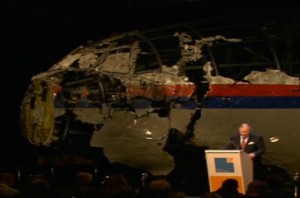
“The crash of flight MH17 on 17 July 2014 was caused by the detonation of a 9N314M-type warhead launched from the eastern part of Ukraine using a Buk missile system,” concluded the Dutch Safety Board investigating the downing of Malaysia Airlines flight MH17.
They based their findings of the type of missile used by fragments found in the wreckage, as well as fragments found in the bodies of the crew.
The findings of the cause of the crash of the ill-fated airliner that went down in eastern Ukraine on July 17th, 2014, were revealed by the DSB in a report and in a press conference on Tuesday.
The majority of the passengers aboard the Malaysia Airliner passenger jet bound for Kuala Lumpur were predominantly Dutch, but there were also passengers from Belgium, Malaysia, Australia, and Ukraine. Representatives from those countries also took part in the Dutch-led investigation, as did additional investigators from other countries.
No blame was assigned by the investigation, but the western world had previously voiced suspicions that it was Russian-backed rebels in eastern Ukraine that shot down the aircraft.
Russia’s state-run missile manufacturer denies that the missile was of the type determined by the investigation, but instead an older model of Russian-made missile. The Russian company also claimed that the missile was not fired from territory controlled by the rebels, but came from the town of Zaroshenske, which was under the control of the Ukrainian government at that time.
The investigation determined that the missile impacted the front left of the aircraft and killed the three-man crew instantly. ” The forward section of the aircraft was penetrated by hundreds of high-energy objects coming from the warhead,” the report stated.
Upon detonation, it was determined that the aircraft broke up mid-air and the wreckage crashed to the earth, killing all 298 occupants.
The findings of the report were supported by the “data on the flight recorders; the Cockpit Voice Recorder picked up a sound peak during the final milliseconds. In addition, traces of paint on a number of missile fragments found match the paint on parts of a missile recovered from the area by Dutch Safety Board. Other potential causes, such as an explosion inside the aeroplane or an air-to-air missile, have been investigated and excluded.”
Although Ukraine had sufficient cause to close the airspace above the conflict, only low altitude flights were restricted. But, rarely is airspace closed because of conflict anywhere in the world. The Malaysia Airliner was only one of 160 commercial airliners that flew through that airspace that day. After the crash, the airspace was closed.
During the investigation, the Dutch reconstructed the forward portion of the aircraft where the missile impact took place. The partially reconstructed jet loomed in the background as the investigators announced their findings at the Hague on Tuesday.
[smoothcategory catg_slug=”world”]
